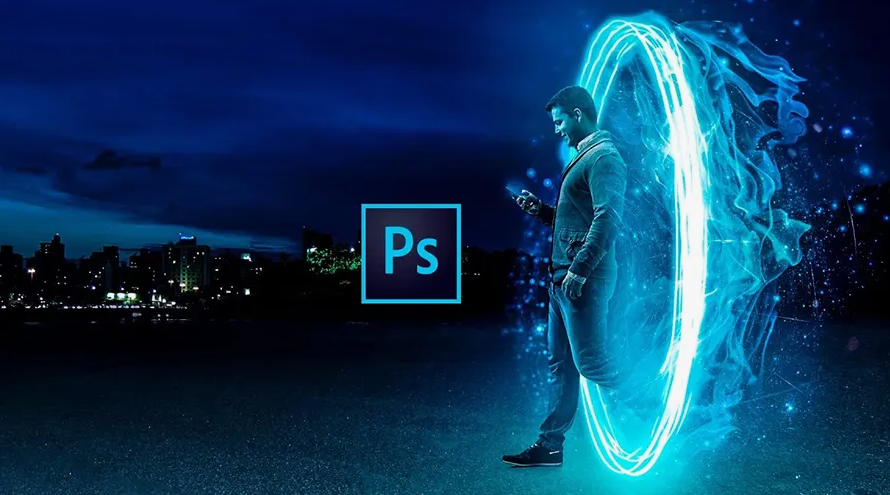Adobe Photoshop is a powerful tool for digital image editing and graphic design. It offers industry-leading tools and one-click transformations for creating, modifying, and enhancing images. With its comprehensive range of features, Photoshop is the go-to software for designers looking to create stunning visuals. Graphic designers in Austin, Texas, and around the world rely on Adobe Photoshop to bring their creative visions to life. Whether it’s designing logos, editing photos, or creating digital artwork, Photoshop’s versatile tools make it a top choice for professionals in the design industry.
We will explore the capabilities of Adobe Photoshop for graphic design and how it can help you unleash your creativity.
Adobe Photoshop Graphic Design

Evolution of Adobe Photoshop
Adobe Photoshop Graphic Design has significantly impacted the digital design industry. The evolution of Adobe Photoshop has transformed the way graphic designers create and manipulate images. This blog post delves into the origins and development of Adobe Photoshop, as well as its key milestones.
Origins and Development- Adobe Photoshop Graphic Design
Adobe Photoshop, initially created by Thomas and John Knoll in 1987, started as a simple image editing program. Over the years, it evolved into a powerful software tool. The development of Photoshop involved continuous innovation and enhancements, leading to the introduction of various features such as layers, filters, and advanced editing tools. It has become the industry standard for graphic design and digital imaging, revolutionizing the way images are edited and manipulated. The software’s evolution has been driven by the demand for more sophisticated design capabilities, resulting in the release of new versions with advanced functionalities.
Key Milestones- Adobe Photoshop Graphic Design
Adobe Photoshop has witnessed several key milestones since its inception. The introduction of layers in Photoshop 3.0 revolutionized the editing process, allowing designers to work on different elements of an image independently. The launch of Photoshop CS2 brought about the Vanishing Point tool, making it easier to clone, paint, and transform objects in a perspective-correct manner. Subsequently, the release of Adobe Creative Cloud (CC) in 2013 shifted Photoshop to a subscription-based model, providing users with access to the latest updates and features.
Key Features of Adobe Photoshop
Adobe Photoshop Graphic Design is a powerful software that is widely used by graphic designers and photographers to create and enhance images. It offers a comprehensive range of tools and features that allow users to modify, refine, and remix their images. In this blog post, we will explore some of the key features of Adobe Photoshop, including layers and masks, filters and effects, and retouching tools.
Layers and Masks
Layers and masks are essential features in Adobe Photoshop that allow users to work with multiple elements and make non-destructive edits to their images. Layers are like transparent sheets that can be stacked on top of each other, enabling users to separate different elements of their design. Masks, on the other hand, allow users to selectively show or hide parts of a layer, giving them greater control over the visibility of specific areas. With layers and masks, designers can easily make adjustments, add effects, and experiment with different design elements without affecting the original image.
Filters and Effects
Adobe Photoshop offers a wide range of filters and effects that can be applied to images to enhance their appearance. Filters can be used to adjust the color, tone, and texture of an image, giving it a unique look and feel. Effects, on the other hand, allow users to add special visual elements such as shadows, glows, and gradients to their designs. Whether you want to create a vintage look, apply a blur effect, or add a dramatic lighting effect, Photoshop provides numerous options to achieve the desired result.
Retouching Tools
Retouching tools in Adobe Photoshop are essential for photographers and designers who want to perfect their images. These tools allow users to remove blemishes, wrinkles, and other imperfections from photos, resulting in a flawless appearance. The healing brush tool, spot healing brush tool, and clone stamp tool are just a few examples of the retouching tools available in Photoshop. Additionally, Photoshop also offers advanced features like content-aware fill and content-aware scale, which make it easier to manipulate and retouch images seamlessly.
Graphic Design Applications
Adobe Photoshop Graphic Design is a powerful tool used by graphic designers to create stunning visual content for various purposes. Graphic Design Applications encompass a wide range of design possibilities, including web design, print design, and digital art.
Web Design
Web design involves creating visual content for websites and online platforms. Adobe Photoshop is widely used for designing web graphics, including website banners, buttons, icons, and other visual elements. It allows designers to create mockups and prototypes for web pages, ensuring a visually appealing and user-friendly design. Moreover, Photoshop’s layer-based editing and image manipulation capabilities make it an essential tool for web designers.
Print Design
Print design focuses on creating visual content for printed materials such as brochures, posters, business cards, and magazines. Adobe Photoshop plays a crucial role in print design by enabling designers to create high-resolution graphics suitable for printing. Its advanced image editing features and color management tools ensure that the final printed materials maintain high-quality visuals.
Digital Art
Digital art encompasses various forms of artistic expression created using digital tools and techniques. Adobe Photoshop provides a versatile platform for digital artists to create stunning artwork, illustrations, and digital paintings. Its extensive set of brushes, filters, and layer blending options offer endless creative possibilities for digital art creation. Furthermore, Photoshop’s support for digital drawing tablets enhances the precision and control of artists, allowing them to unleash their creativity digitally.
Workflow In Adobe Photoshop
Adobe Photoshop is a popular graphic design software used by professionals and amateurs alike. With its comprehensive range of tools, users can create, modify, refine, and remix images to their liking. To effectively use Adobe Photoshop, it is important to understand the workflow involved in creating a project. In this blog post, we will discuss how to set up a project, work with the tools, and export and save your work.

Setting Up A Project
Before starting any project, it is important to set up the workspace in Adobe Photoshop. You can customize your workspace by selecting the appropriate layout and tools you need. Here are some tips to help you set up your project:
- Choose the appropriate document size and resolution for your project.
- Customize your workspace by selecting the appropriate layout and tools.
- Set up your layers and groups to keep your project organized.
- Use guides and rulers to align your elements properly.
Working With Tools
Adobe Photoshop comes with a wide range of tools that can be used to create and edit images. Here are some tips to help you work with the tools:
- Use the selection tools to choose and manipulate specific areas of your image.
- Use the brush tools to paint and fill areas of your image.
- Use the transform tools to resize, rotate, and distort your image.
- Use the layer and mask tools to control the visibility and transparency of your elements.
Exporting And Saving
Once you are done with your project, it is important to export and save your work properly. Here are some tips to help you export and save your work:
- Choose the appropriate file format and compression for your project.
- Use the Save and Save As options to save your project in the appropriate format.
- Use the Export option to export your project in different formats for web or print.
- Use the Automate option to batch-process your images for quick editing.
Advanced Techniques
Adobe Photoshop Graphic Design is a powerful tool for creating and editing digital images. With its advanced techniques, designers can take their skills to the next level and create stunning visuals. In this blog post, we will explore some of the advanced techniques in Adobe Photoshop Graphic Design, including mastering selections, color correction, and typography.
Mastering Selections
Mastering selections is crucial in Adobe Photoshop Graphic Design as it allows designers to isolate specific areas of an image for editing or manipulation. Here are some tips to help you master selections:
- Use the various selection tools, such as the Marquee tool, Lasso tool, and Quick Selection tool, to make precise selections.
- Experiment with different selection techniques, such as feathering and refining edges, to achieve seamless and natural-looking selections.
- Combine selection tools with layer masks to create non-destructive edits and easily adjust your selections later on.
- Utilize advanced selection techniques like the Pen tool for complex shapes and the Color Range tool for selecting specific colors or tones.
Color Correction
Color correction is essential in Adobe Photoshop Graphic Design to ensure accurate and consistent colors in your images. Here are some color correction techniques you can use:
| Technique | Description |
|---|---|
| Levels Adjustment | Adjust the tonal range of your image by manipulating the histogram. |
| Curves Adjustment | Modify the contrast and color balance of your image using curves. |
| Color Balance | Correct color casts and adjust the overall color balance of your image. |
| Hue/Saturation | Alter the hue, saturation, and lightness of specific colors in your image. |
Typography
Typography plays a crucial role in Adobe Photoshop Graphic Design as it enhances the visual appeal and readability of your designs. Here are some typography tips to consider:
- Choose fonts wisely, considering their style, legibility, and appropriateness for your design.
- Experiment with font pairing to create harmonious and visually interesting combinations.
- Adjust kerning, leading, and tracking to improve the spacing and readability of your text.
- Utilize text effects like drop shadows, strokes, and gradients to make your typography stand out.
- Consider the hierarchy of your text by using different font sizes, weights, and styles to emphasize important information.
Integration With Other Adobe Creative Cloud Apps
Adobe Photoshop Graphic Design and Integration with Other Adobe Creative Cloud Apps allow seamless workflows across various Adobe applications.
Using Adobe Stock
Adobe Stock provides a vast library of high-quality images, graphics, and videos that enhance your design projects. You can easily search for assets directly within Photoshop, license them, and integrate them into your designs.
Working With Adobe Illustrator
Adobe Illustrator complements Photoshop by offering vector-based design capabilities. You can create scalable graphics, logos, and illustrations in Illustrator and import them seamlessly into your Photoshop projects for further manipulation.
Collaborating With Adobe Xd
Adobe XD enables efficient collaboration on design projects. You can create interactive prototypes and share them with team members for feedback. Integrating XD with Photoshop streamlines the design-to-prototype workflow.
Career Opportunities In Photoshop Graphic Design
Adobe Photoshop Graphic Design is a popular field that offers various career opportunities. Professionals in this field create and modify digital images using Adobe Photoshop software. The demand for skilled graphic designers is increasing day by day. In this blog post, we will discuss the different career opportunities available in Photoshop Graphic Design.
Freelancing
Freelancing is a popular career choice in the field of Photoshop Graphic Design. Freelancers work independently and provide their services to clients on a project basis. They have the flexibility to choose their projects and clients. Freelancers can work from anywhere and can set their rates. However, it requires self-discipline, time management skills, and marketing skills to succeed as a freelancer.
In-house Design Positions
In-house design positions are available in various industries such as advertising, marketing, and publishing. In-house designers work for a specific company and are responsible for creating designs for the company’s products and services. They work closely with the marketing team and other departments to ensure that the designs meet the company’s objectives. In-house designers also have the opportunity to work on a variety of projects and develop their skills.
Specialized Fields
There are several specialized fields in Photoshop Graphic Design that you can choose from based on your interests and skills. Some of the specialized fields include web design, UX/UI design, packaging design, and motion graphics. Web designers are responsible for creating designs for websites, while UX/UI designers focus on creating user-friendly interfaces. Packaging designers create designs for product packaging and motion graphics designers create animated graphics for videos and films.

Future Trends In Photoshop Graphic Design
The future of Adobe Photoshop graphic design is heading towards more AI-driven tools and automation, allowing designers to create and modify images with greater efficiency. Additionally, there is a growing focus on collaboration and integration with other Adobe Creative Cloud applications, offering a seamless workflow for designers.
Conclusion
Enhance your graphic design skills with Adobe Photoshop’s powerful tools for image creation and editing. Save time and unleash your creativity with AI features. Dive into a world of endless possibilities and take your designs to the next level with Adobe Photoshop. Elevate your designs today.

